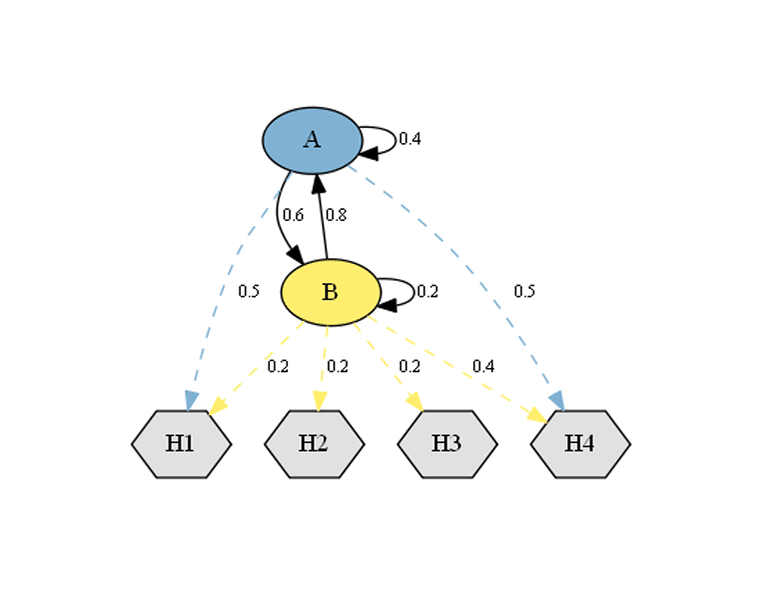PyDTMC Save
A library for discrete-time Markov chains analysis.
PyDTMC
PyDTMC is a full-featured and lightweight library for discrete-time Markov chains analysis. It provides classes and functions for creating, manipulating, simulating and visualizing Markov processes.
| Status: |



|
| Info: |



|
| PyPI: |




|
| Conda: |




|
| Donation: |

|
Requirements
The Python environment must include the following packages:
Notes:
- It's recommended to install Graphviz and pydot before using the
plot_graphfunction. - The packages pytest and pytest-benchmark are required for performing unit tests.
- The package Sphinx is required for building the package documentation.
Installation & Upgrade
PyPI:
$ pip install PyDTMC
$ pip install --upgrade PyDTMC
Git:
$ pip install https://github.com/TommasoBelluzzo/PyDTMC/tarball/master
$ pip install --upgrade https://github.com/TommasoBelluzzo/PyDTMC/tarball/master
$ pip install git+https://github.com/TommasoBelluzzo/PyDTMC.git#egg=PyDTMC
$ pip install --upgrade git+https://github.com/TommasoBelluzzo/PyDTMC.git#egg=PyDTMC
$ conda install -c conda-forge pydtmc
$ conda update -c conda-forge pydtmc
$ conda install -c tommasobelluzzo pydtmc
$ conda update -c tommasobelluzzo pydtmc
Usage: MarkovChain Class
The MarkovChain class can be instantiated as follows:
>>> p = [[0.2, 0.7, 0.0, 0.1], [0.0, 0.6, 0.3, 0.1], [0.0, 0.0, 1.0, 0.0], [0.5, 0.0, 0.5, 0.0]]
>>> mc = MarkovChain(p, ['A', 'B', 'C', 'D'])
>>> print(mc)
DISCRETE-TIME MARKOV CHAIN
SIZE: 4
RANK: 4
CLASSES: 2
> RECURRENT: 1
> TRANSIENT: 1
ERGODIC: NO
> APERIODIC: YES
> IRREDUCIBLE: NO
ABSORBING: YES
MONOTONE: NO
REGULAR: NO
REVERSIBLE: YES
SYMMETRIC: NO
Below a few examples of MarkovChain properties:
>>> print(mc.is_ergodic)
False
>>> print(mc.recurrent_states)
['C']
>>> print(mc.transient_states)
['A', 'B', 'D']
>>> print(mc.steady_states)
[array([0.0, 0.0, 1.0, 0.0])]
>>> print(mc.is_absorbing)
True
>>> print(mc.fundamental_matrix)
[[1.50943396, 2.64150943, 0.41509434]
[0.18867925, 2.83018868, 0.30188679]
[0.75471698, 1.32075472, 1.20754717]]
>>> print(mc.kemeny_constant)
5.547169811320755
>>> print(mc.entropy_rate)
0.0
Below a few examples of MarkovChain methods:
>>> print(mc.absorption_probabilities())
[1.0 1.0 1.0]
>>> print(mc.expected_rewards(10, [2, -3, 8, -7]))
[44.96611926, 52.03057032, 88.00000000, 51.74779651]
>>> print(mc.expected_transitions(2))
[[0.0850, 0.2975, 0.0000, 0.0425]
[0.0000, 0.3450, 0.1725, 0.0575]
[0.0000, 0.0000, 0.7000, 0.0000]
[0.1500, 0.0000, 0.1500, 0.0000]]
>>> print(mc.first_passage_probabilities(5, 3))
[[0.5000, 0.0000, 0.5000, 0.0000]
[0.0000, 0.3500, 0.0000, 0.0500]
[0.0000, 0.0700, 0.1300, 0.0450]
[0.0000, 0.0315, 0.1065, 0.0300]
[0.0000, 0.0098, 0.0761, 0.0186]]
>>> print(mc.hitting_probabilities([0, 1]))
[1.0, 1.0, 0.0, 0.5]
>>> print(mc.mean_absorption_times())
[4.56603774, 3.32075472, 3.28301887]
>>> print(mc.mean_number_visits())
[[0.50943396, 2.64150943, INF, 0.41509434]
[0.18867925, 1.83018868, INF, 0.30188679]
[0.00000000, 0.00000000, INF, 0.00000000]
[0.75471698, 1.32075472, INF, 0.20754717]]
>>> print(mc.simulate(10, seed=32))
['D', 'A', 'B', 'B', 'C', 'C', 'C', 'C', 'C', 'C', 'C']
>>> sequence = ["A"]
>>> for i in range(1, 11):
... current_state = sequence[-1]
... next_state = mc.next(current_state, seed=32)
... print((' ' if i < 10 else '') + f'{i}) {current_state} -> {next_state}')
... sequence.append(next_state)
1) A -> B
2) B -> C
3) C -> C
4) C -> C
5) C -> C
6) C -> C
7) C -> C
8) C -> C
9) C -> C
10) C -> C
Below a few examples of MarkovChain plotting functions; in order to display the output of plots immediately, the interactive mode of Matplotlib must be turned on:
>>> plot_eigenvalues(mc, dpi=300)
>>> plot_graph(mc, dpi=300)
>>> plot_sequence(mc, 10, plot_type='histogram', dpi=300)
>>> plot_sequence(mc, 10, plot_type='heatmap', dpi=300)
>>> plot_sequence(mc, 10, plot_type='matrix', dpi=300)
>>> plot_redistributions(mc, 10, plot_type='heatmap', dpi=300)
>>> plot_redistributions(mc, 10, plot_type='projection', dpi=300)

Usage: HiddenMarkovModel Class
The HiddenMarkovModel class can be instantiated as follows:
>>> p = [[0.4, 0.6], [0.8, 0.2]]
>>> states = ['A', 'B']
>>> e = [[0.5, 0.0, 0.0, 0.5], [0.2, 0.2, 0.2, 0.4]]
>>> symbols = ['H1', 'H2', 'H3', 'H4']
>>> hmm = HiddenMarkovModel(p, e, states, symbols)
>>> print(hmm)
HIDDEN MARKOV MODEL
STATES: 2
SYMBOLS: 4
ERGODIC: NO
REGULAR: NO
Below a few examples of HiddenMarkovModel methods:
>>> sim_states, sim_symbols = hmm.simulate(12, seed=1488)
>>> print(sim_states)
['B', 'A', 'A', 'A', 'B', 'A', 'A']
>>> print(sim_symbols)
['H2', 'H4', 'H4', 'H4', 'H3', 'H4', 'H4']
>>> est_hmm = hmm.estimate(states, symbols, sim_states, sim_symbols)
>>> print(est_hmm.p)
[[0.75, 0.25]
[1.00, 0.00]]
>>> print(est_hmm.e)
[[0.0, 0.0, 0.0, 1.0]
[0.0, 0.5, 0.5, 0.0]]
>>> dec_lp, dec_posterior, dec_backward, dec_forward, _ = hmm.decode(sim_symbols)
>>> print(dec_lp)
-8.77549587
>>> print(dec_posterior)
[[0.00000000, 0.84422968, 0.41785105, 0.84422968, 0.00000000, 0.82089552, 0.52238806]
[1.00000000, 0.15577032, 0.58214895, 0.15577032, 1.00000000, 0.17910448, 0.47761194]]
>>> print(dec_backward)
[[1.50000000, 0.88942581, 1.01307561, 0.79988630, 1.31154065, 0.94776119, 0.98507463, 1.00000000]
[0.50000000, 1.00000000, 0.93462194, 1.21887436, 0.43718022, 1.00000000, 1.07462687, 1.00000000]]
>>> print(dec_forward)
[[0.50000000, 0.00000000, 0.83333333, 0.52238806, 0.64369311, 0.00000000, 0.83333333 0.52238806]
[0.50000000, 1.00000000, 0.16666667, 0.47761194, 0.35630689, 1.00000000, 0.16666667 0.47761194]]
>>> pre_lp, pre_states = hmm.predict('viterbi', sim_symbols)
>>> print(pre_lp)
-13.24482936
>>> print(pre_states)
['B', 'A', 'B', 'A', 'B', 'A', 'B']
Below a few examples of HiddenMarkovModel plotting functions; in order to display the output of plots immediately, the interactive mode of Matplotlib must be turned on:
>>> plot_graph(hmm, dpi=300)
>>> plot_sequence(hmm, 10, plot_type='histogram', dpi=300)
>>> plot_sequence(hmm, 10, plot_type='heatmap', dpi=300)
>>> plot_sequence(hmm, 10, plot_type='matrix', dpi=300)
>>> plot_trellis(hmm, 10, dpi=300)

